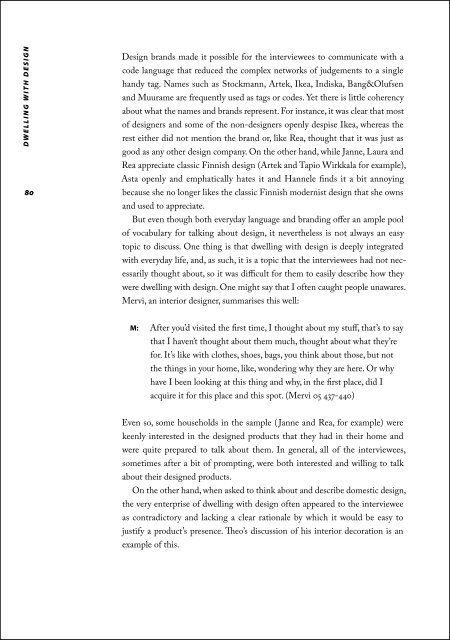Lataa ilmaiseksi
Lataa ilmaiseksi
Lataa ilmaiseksi
Create successful ePaper yourself
Turn your PDF publications into a flip-book with our unique Google optimized e-Paper software.
D W E L L I N G W I T H D E S I G N<br />
80<br />
Design brands made it possible for the interviewees to communicate with a<br />
code language that reduced the complex networks of judgements to a single<br />
handy tag. Names such as Stockmann, Artek, Ikea, Indiska, Bang&Olufsen<br />
and Muurame are frequently used as tags or codes. Yet there is little coherency<br />
about what the names and brands represent. For instance, it was clear that most<br />
of designers and some of the non-designers openly despise Ikea, whereas the<br />
rest either did not mention the brand or, like Rea, thought that it was just as<br />
good as any other design company. On the other hand, while Janne, Laura and<br />
Rea appreciate classic Finnish design (Artek and Tapio Wirkkala for example),<br />
Asta openly and emphatically hates it and Hannele finds it a bit annoying<br />
because she no longer likes the classic Finnish modernist design that she owns<br />
and used to appreciate.<br />
But even though both everyday language and branding offer an ample pool<br />
of vocabulary for talking about design, it nevertheless is not always an easy<br />
topic to discuss. One thing is that dwelling with design is deeply integrated<br />
with everyday life, and, as such, it is a topic that the interviewees had not necessarily<br />
thought about, so it was difficult for them to easily describe how they<br />
were dwelling with design. One might say that I often caught people unawares.<br />
Mervi, an interior designer, summarises this well:<br />
M: After you’d visited the first time, I thought about my stuff, that’s to say<br />
that I haven’t thought about them much, thought about what they’re<br />
for. It’s like with clothes, shoes, bags, you think about those, but not<br />
the things in your home, like, wondering why they are here. Or why<br />
have I been looking at this thing and why, in the first place, did I<br />
acquire it for this place and this spot. (Mervi 05 437-440)<br />
Even so, some households in the sample ( Janne and Rea, for example) were<br />
keenly interested in the designed products that they had in their home and<br />
were quite prepared to talk about them. In general, all of the interviewees,<br />
sometimes after a bit of prompting, were both interested and willing to talk<br />
about their designed products.<br />
On the other hand, when asked to think about and describe domestic design,<br />
the very enterprise of dwelling with design often appeared to the interviewee<br />
as contradictory and lacking a clear rationale by which it would be easy to<br />
justify a product’s presence. Theo’s discussion of his interior decoration is an<br />
example of this.
















